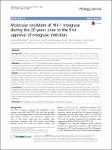Molecular evolution of HIV-1 integrase during the 20 years prior to the first approval of integrase inhibitors
Meixenberger, Karolin
Yousef, Kaveh Pouran
Smith, Maureen Rebecca
Somogyi, Sybille
Fiedler, Stefan
Bartmeyer, Barbara
Hamouda, Osamah
Bannert, Norbert
Kleist, Max von
Kücherer, Claudia
Background: Detailed knowledge of the evolutionary potential of polymorphic sites in a viral protein is important for understanding the development of drug resistance in the presence of an inhibitor. We therefore set out to analyse the molecular evolution of the HIV-1 subtype B integrase at the inter-patient level in Germany during a 20-year period prior to the first introduction of integrase strand inhibitors (INSTIs). Methods: We determined 337 HIV-1 integrase subtype B sequences (amino acids 1–278) from stored plasma samples of antiretroviral treatment-naïve individuals newly diagnosed with HIV-1 between 1986 and 2006. Shannon entropy was calculated to determine the variability at each amino acid position. Time trends in the frequency of amino acid variants were identified by linear regression. Direct coupling analysis was applied to detect covarying sites. Results: Twenty-two time trends in the frequency of amino acid variants demonstrated either single amino acid exchanges or variation in the degree of polymorphy. Covariation was observed for 17 amino acid variants with a temporal trend. Some minor INSTI resistance mutations (T124A, V151I, K156 N, T206S, S230 N) and some INSTI-selected mutations (M50I, L101I, T122I, T124 N, T125A, M154I, G193E, V201I) were identified at overall frequencies >5%. Among these, the frequencies of L101I, T122I, and V201I increased over time, whereas the frequency of M154I decreased. Moreover, L101I, T122I, T124A, T125A, M154I, and V201I covaried with non-resistance-associated variants. Conclusions: Time-trending, covarying polymorphisms indicate that long-term evolutionary changes of the HIV-1 integrase involve defined clusters of possibly structurally or functionally associated sites independent of selective pressure through INSTIs at the inter-patient level. Linkage between polymorphic resistance- and non-resistance-associated sites can impact the selection of INSTI resistance mutations in complex ways. Identification of these sites can help in improving genotypic resistance assays, resistance prediction algorithms, and the development of new integrase inhibitors.
No license information

